Ledger Projects signs collaboration agreement with Bitfury Group
Ledger Projects Sponsors Pre Launch Party of The Delta Summit, at The Auberge De Castille
Ledger Projects is proud to sponsor the official launch of the build-up towards DELTA Summit 2018, which will take place in October 3rd to 5th.
DELTA Summit is the Maltese Government’s official Digital Innovation & Blockchain conference. The event will offer intellectually stimulating discussions with global leaders & networking opportunities with key players in this new exciting sector where Malta has become the world’s main leader.
The event will feature a fireside chat with Hon. Silvio Schembri, Tim Draper & Dr. Abdalla Kablan.
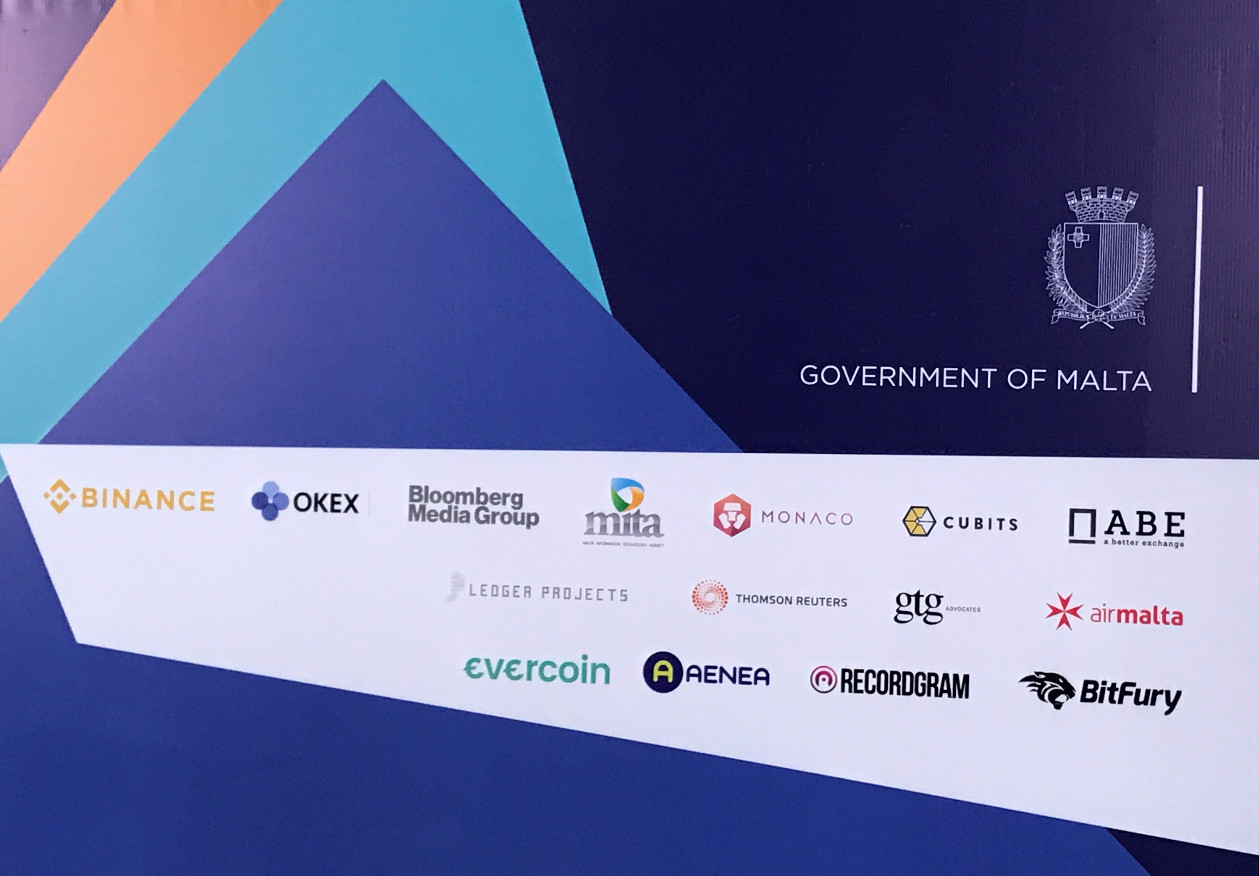
Create your Blockchain DApp with Ethereum and VueJS – Part 1
In this first part of the tutorial we are going to create the smart contract that handles the registration of users; then we are going to deploy the smart contract to the blockchain using Truffle.
If you missed the introduction and you want to know what this tutorial is about, please read the intro.
This part of tutorial is divided into three sections:
- Set up of the truffle environment.
- Smart contract development.
- Deploy the smart contract to the blockchain.
Note before you start: if you are using Windows you must use Power Shell as terminal.
Set up of the truffle environment
First let’s create the project folder called ethereum-vuejs-dapp, then open the terminal in the folder just created and run the following command:
$ truffle init
This command initializes the truffle project and creates the following items:
- contracts: folder containing the smart contracts written in Solidity.
- migrations: folder containing the files that take care of the deployment.
- test: folder containing the files for testing the smart contracts.
- truffle.js: file that contains the list of blockchain networks where you can deploy your contracts.
Let’s add the details of our blockchain network to the file truffle.js. So first start Ganache and, once it runs, check the host and the port as shown below.

Now paste the following code in truffle.js:
module.exports = {
networks: {
ganache: {
host: "127.0.0.1",
port: 7545,
network_id: "*"
}
}
};
IMPORTANT: make sure that the host and the port of the code pasted in truffle.js match with the settings displayed in Ganache.
Smart contract development
As described in the introduction, the main features of our dApp are:
- Let users resister their profiles.
- The owner of a profile is the only person who can edit his own information.
The following information of a user’s profile is going to be stored in the blockchain:
- Name of the owner.
- Status.
- When the profile has been created and updated.
What we need is to store the list of the users and associate each user with an account address (or wallet address).
The smart contract must provide a set of functions that:
- Let the user register his profile.
- Let the owner of a profile update his details.
- Get the list of users and their details.
- Check if the user is already registered.
Below is the code of the smart contract (you can find it on GitHub as well).
Deploy the smart contract to the blockchain
It’s time to deploy the smart contract to the blockchain! Make sure that your blockchain is running and the file truffle.js is properly set as explained before.
Go to the folder migration and create a file called 2_migrate_users.js.
The migration filename has a number as prefix and a description as suffix. The numbered prefix is required in order to record whether the migration ran successfully and the suffix just describes what the file is about.
Copy and paste the following code inside the file 2_migrate_users.js:
var Users = artifacts.require("./Users.sol");
deployer.deploy(Users);
};
Now let’s open the terminal in the project folder ethereum-vuejs-dapp and run the command:
$ truffle console ––network ganache
Once the truffle console is running, type the following command:
>> migrate ––reset ––compile-all
This command compiles all smart contracts and deploys the smart contracts to the blockchain.
If everything went fine, on the console you should see a message as follows:
Compiling .\contracts\Migrations.sol... Compiling .\contracts\Users.sol... Writing artifacts to .\build\contracts Using network 'ganache'. Running migration: 1_initial_migration.js Replacing Migrations... ... 0x18edd24941e9b7edfae4966af544d5413e31622da90cecae2d3153635a7ffba2 Migrations: 0xcac26201ab3b38d2f0f9b56f81a8897dfe036da6 Saving successful migration to network... ... 0x125c70f37e143b13acb4827dda16e8571758402db81c08a3a2ae27573910105f Saving artifacts... Running migration: 2_migrate_users.js Replacing Users... ... 0x043c2cf363da321b8a1ec06672f12fd794bf894342fa51100250bc6975806385 Users: 0x782b9ce19fe792ed3c4ccbfb439ab59ddc5369f2 Saving successful migration to network... ... 0x9e56386f94093c4f56f6b84190503376363f15a6d16661e7bfaa8fefe1b4be1f Saving artifacts... truffle(ganache)>
After the deployment you will see on Ganache some new transactions in the transaction list.
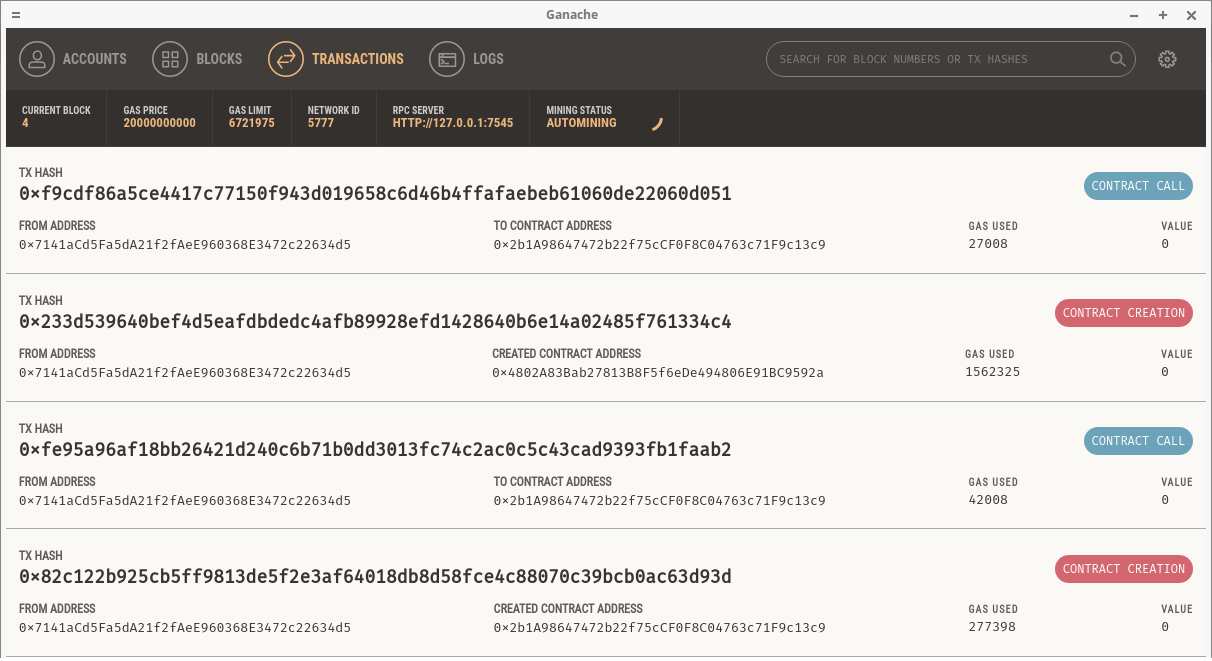
In the second part of the tutorial we will build the dApp interface using Vue JS and interact with the smart contracts through the interface.
The second part of the tutorial is on the way… see you soon!
___________
Read the original article at www.danielefavi.com
___________
Create your Blockchain DApp with Ethereum and VueJS – Intro
This is a simple decentralized application built using Ethereum blockchain and VueJS for the front-end. This DApp example lets the users store their name and status on the blockchain.
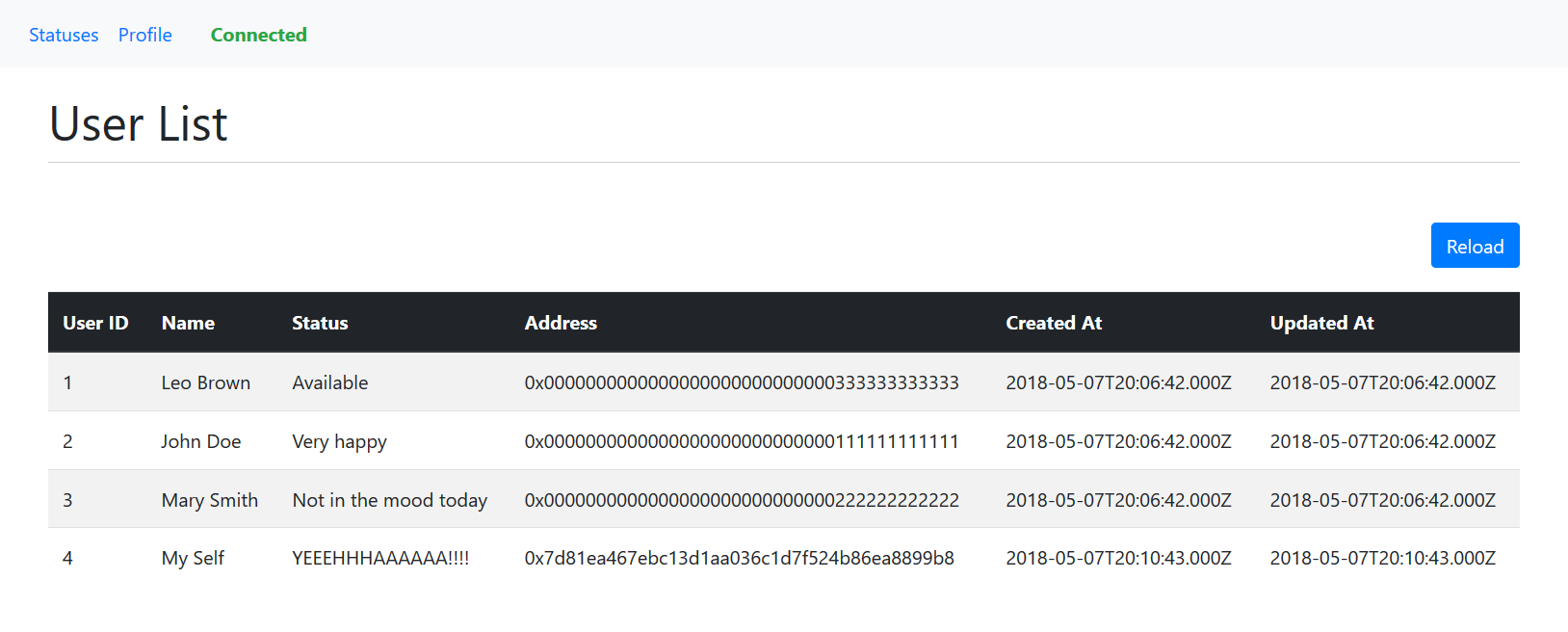
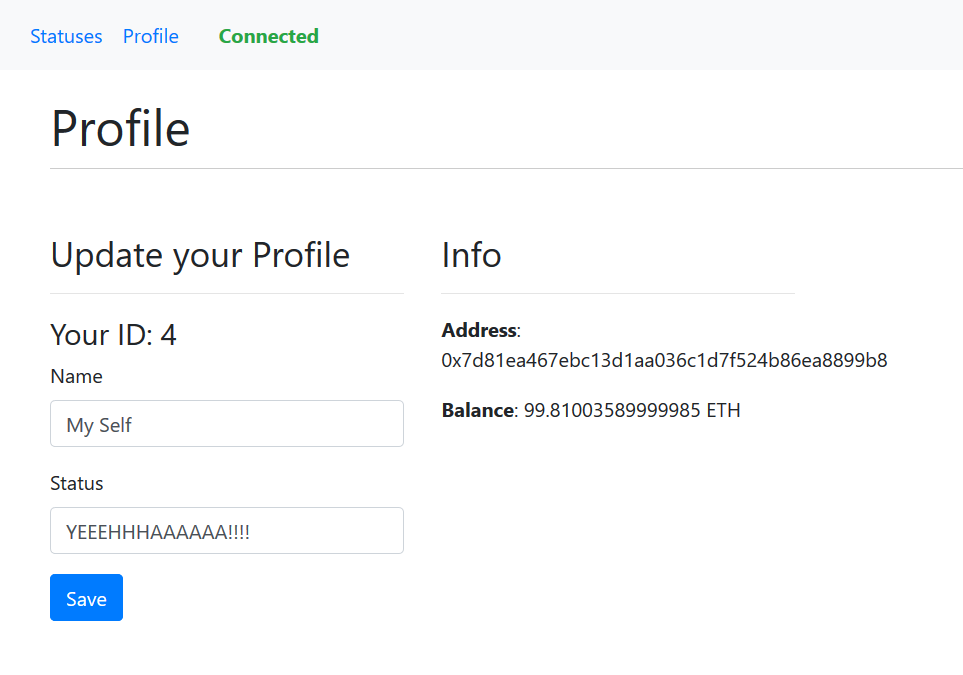
Brief description
The DApp allows users to register their name and status on the blockchain. The user’s profile is associated with an account address (or wallet address).
The owner of the profile is the only person who can modify his own data. This will give you a technical explanation of what it means when the user is in control of his own data (just like Facebook… sarcasm!).
The smart contract is designed to give the user control of his own information and not even the creator of the smart contract can control any data.
This tutorial is split in two parts:
- PART 1 (coming soon): set up of the truffle environment, brief explanation of the smart contract and deploy the smart contract to the blockchain.
- PART 2 (coming soon): set up Vue JS and explanation of the project structure.
Prerequisite
- NPM version 5.8.0
- TRUFFLE verson 4.1.5
- Ganache or your private network.
- Metamask: not mandatory but better if you want to insert different profiles.
Quick Start
- Download the project and decompress it into the folder
~/ethereum-vuejs-dapp(or wherever you want). - Start Ganache (or your private blockchain).
- Open the terminal (if you are using Windows you must use the Power Shell) in the folder
~/ethereum-vuejs-dappand run the command:$ truffle console ––network ganache
- If ganache is running you should be inside the truffle console; now run the following command in the truffle console:
> migrate ––reset ––compile-all
- If the migration was successful, copy the content of the file
~/ethereum-vuejs-dapp/build/contracts/Users.jsoninto~/ethereum-vuejs-dapp/app-users/src/assets/UsersContract.json - Open another terminal in the folder
~/ethereum-vuejs-dapp/app-usersand run the command:$ npm install
- Once all the dependencies are installed run the command:
$ npm run dev
If everything went fine you should see this message:
Your application is running here: http://localhost:8080
- Open the browser and go to URL above to try the DApp!
NOTE: if you want to try to add more profiles you have to install metamask in your browser, then import the accounts into metamask and finally change account on metamask in order to register a new profile.
___________
Read the original article at www.danielefavi.com
___________
What is a fork? Why is it dangerous?
Often a blockchain can have some flaws, bugs or it just needs improvements. To fix those vulnerabilities the blockchain has to be forked.
A fork rewrites the rules which a full node must follow in order to consider a block valid. A full node can decide either to accept the new rule (updating its software) or reject it.
If some nodes choose to support the fork while others choose not to do so, then a blockchain fork might happen: in this case the blockchain splits up in two different branches.
The two blockchains share the same chunk of chain from the genesis block to a certain block before the divergence.
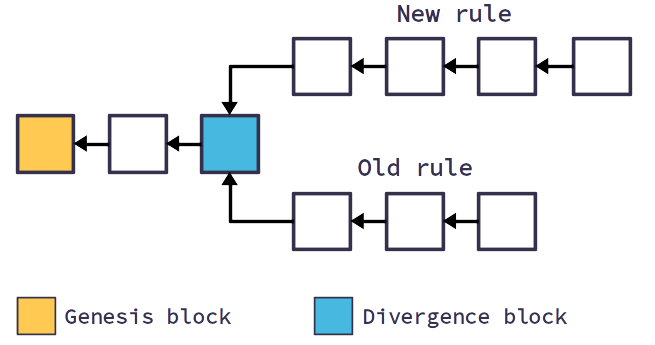
There are two kinds of fork: hard fork and soft fork. Both hard and soft forks can cause a blockchain fork.
When a fork happens, the choice made by the community is crucial because it can weaken the blockchain. When the community of the full nodes split then each branch of the blockchain created by the split will have less hashpower: so both blockchains become weak to a 51% attack.
If the community cannot make a strong decision about the fork, then also the community itself can become weak; this could lead to bad consequences regarding the trust on the platform: the reliability of the platform will decrease and the interest of investors and developers will move away.
Let’s take some real examples.
Before August 2017, the bitcoin community was discussing how to improve the bitcoin transaction performance (aka scalability). The community had two different opinions:
- to increase the block size to 8MB
- to store the data within a block with a method called SegWit [1]
In August 2017 the bitcoin blockchain split up in two branches: Bitcoin Cash [2] with an increased block size to 8M and Bitcoin that uses SegWit.
Another example.
In 2016 an attacker managed to use the vulnerability of ethereum security for his own good and many people lost their investments [3]. Within the ethereum community there were two ways to solve this problem:
- to revert the transactions due to the flaw
- not to make any changes, keeping the original protocol
In July 2016 the ethereum blockchain forked into Ethereum (with the flaw fixed) and Ethereum Classic (original protocol) [3].
What is the difference between hard fork and soft fork?
Soft fork: a block created with a new rule is considered valid also by the old rule; this means a soft fork is forward compatible (in other words the blocks created with the new rule are compatible with the blocks created with the old rule but not the other way around).
Example: you have a blockchain where each block has a maximum size of 2MB; then you apply a soft fork to reduce the maximum size of the block to 1MB. The old rule will consider the blocks created with the new rule valid since they do not exceed the 2MB maximum size.
Hard fork: blocks created with the new rule are not considered valid by the old rule; this means that a hard fork is not forward compatible (the blocks created with the new rule are not compatible with the blocks created with the old rule).
Example: a blockchain has the block size limit of 1MB; then a hard fork is applied in order to increase the block size limit to 3MB. The blocks created with the hard fork rule are not compatible with the old rule since the 3MB limit exceeded the 1MB limit but the old blocks are still compatible with the new rule.
SOFT FORK: how does the blockchain fork happen?
If the hashpower of the full nodes that accepted the soft fork is 51% or more, then there will be no blockchain fork.
If less than 51% of the hashpower comes from the full nodes which do not support the soft fork then the blockchain will split: a branch of blocks will be created by the nodes following the old rule (since the old rule is not compatible with the new rule) and another branch of blocks by the nodes following the new rule.
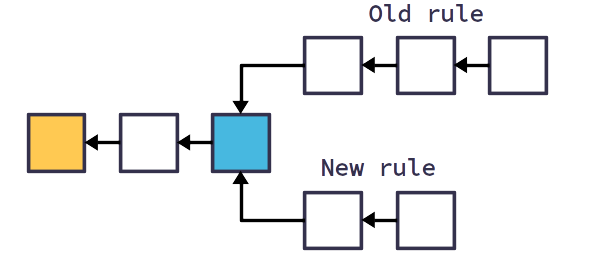
If the full nodes start upgrading their software to the soft fork and the hashing power supporting the soft fork is more than 51%, then all the network (both supporting and not supporting the fork) will consider the blockchain branch created with the soft fork rule as true.
This is possible because the branch created with the soft fork became longer than the other branch; since the soft fork branch is compatible with the old rule, all the network will consider the longer branch valid and there will be one single branch.
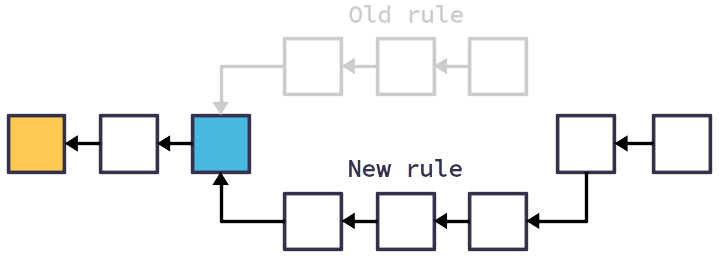
HARD FORK: how does the blockchain fork happen?
Here we have to consider two cases.
Case 1: 51% of the hashpower of the network do not update their software to the hard fork.
Since the blocks created with the old rule are compatible with the hard fork and the blockchain branch supported by the old rule grow faster (because it has more hashpower), then the blockchain branch supported by the old rule is considered valid and there is no blockchain split.
Case 2: 51% of the full nodes update their software to the hard fork but a smaller percentage is still using the old rule.
In this case the blockchain will split: since the blocks created with the hard fork rule are not compatible with the old rule then there will be a branch supported by the nodes following the old rule and a branch supported by the nodes following the hard fork.
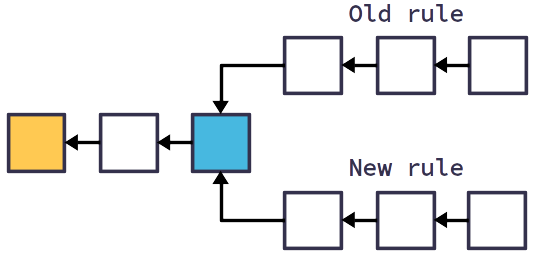
Obviously in case when 100% of the community supports or does not support the hard fork there will be no blockchain split.
References
[2] SegWit Protocol – CoinDesk
[3] The stolen ether and the birth of Ethereum Classic:
[4] 51% Attack
Sources
Guide to Forks: Everything You Need to Know About Forks, Hard Fork and Soft Fork
___________
Binance is moving to Malta – Crypto Has Just Found a Friendly Island in the Sun
Ones to Watch: Ledger Projects
Go to the original article:
https://maltaprofile.info/article/ones-to-watch-ledger-projects
The dazzling allure of Cyptocurrency – In collaboration with CoinCentral.com
This week we teamed up with Jeff Reblora, from Coin Central who wrote a paper that attempts to dispel myths within the cryptocurrency world. We look forward to collaborating with Jeff and his colleagues at Coin Central again in the near future.
This article is originally published at CoinCentral.com
Where is the blockchain revolution?
A friend of mine asked me: bitcoin was invented 10 years ago, why has not anyone come up with a real product yet? Has anything been disrupted by blockchain?
His disappointment is quite understandable.
Everyone is talking about blockchain as a revolutionary technology, they say it will change how we approach the life, make transactions cheaper and free us from the middle man.
Many times I heard how Air B&B and Amazon will be wiped out by blockchain technology and how blockchain will protect our privacy from Facebook and Google.
Nowadays there are many products based on blockchain but none of them have been revolutionary, none of them changed our approach to life like the first PC, the first iPhone or Facebook.
Where is the claimed disruption?
Enthusiasts are claiming that blockchain will disrupt many industries in the future, but what about now?
No revolution happened yet, lots of good words, speculation and euphoria; even Bitcoin is failing its purpose as a means of payment [1].
The blinding light of making easy money on bitcoin hooked many people; it seduced not just investors and cyber-nerds but also normal people, everyone is hunting for a new business opportunity. If this euphoria does not match with a real solution it will soon turn into disappointment (as I am already reading around).
And the euphoria is a close friend of speculation, not just on bitcoin’s economy but also on the blockchain as term itself; for instance a tea company changed its name from Long Island Iced Tea to Long Blockchain and it got +500% increase on its shares [2]. Isn’t it crazy?
So what’s the state of work right now?
Let’s be realistic: blockchain is a new technology and it is still in development, experimentation and testing. Bitcoin blockchain is still fighting on performance (like transaction speed and fees).
Perhaps in 10 years blockchain will revolutionize our life, or it may fail as well.
Internet was invented in the 1950s but it boomed forty years later in the 1990s [3]. The artificial intelligence was invented in the 1950s but it boomed in 2015 [4].
Bitcoin’s white paper came out in 2008 [5] and now, ten years later, what has been accomplished by blockchain technology?
A lot.
No revolutionary products have been invented yet but many new blockchain platforms were born (like Ripple, Ethereum, Hyperledger or Iota): remember that blockchain is a new world to discover and it is still in development. When the foundation is ready new blockchain products will come out.
Many big tech corporations (like IBM or Microsoft) as well as banks are investing a lot in it.
I’m investing my free time in studying blockchain development and I personally think blockchain will help the humankind technology evolution.
Now it is the right time to invest in this technology if you want to be in the forefront in a close future. Be aware that blockchain might fail as well but no investment comes without risk.
The history of blockchain just started. Don’t let the mass euphoria, disappointment or skepticism blind you, stay calm and keep yourself informed instead.
___________
References
[1] Why bitcoin is failing its purpose as a means of payment:
- https://bitinfocharts.com/comparison/bitcoin-transactionfees.html
- Bloomberg.com – Bitcoin’s High Transaction Fees Show Its Limits
- thenextweb.com – Bitcoin.org has abandoned its claims for fast transactions at low fees… for now
[2] Tea company that chaged its name: https://techcrunch.com/2017/12/21/long-island-iced-tea-shares-went-gangbusters-after-changing-its-name-to-long-blockchain/
[3] History of the internet: https://en.wikipedia.org/wiki/History_of_the_Internet
[4] History of AI: https://en.wikipedia.org/wiki/History_of_artificial_intelligence
[5] History of Bitcoin: https://en.wikipedia.org/wiki/History_of_bitcoin
___________










